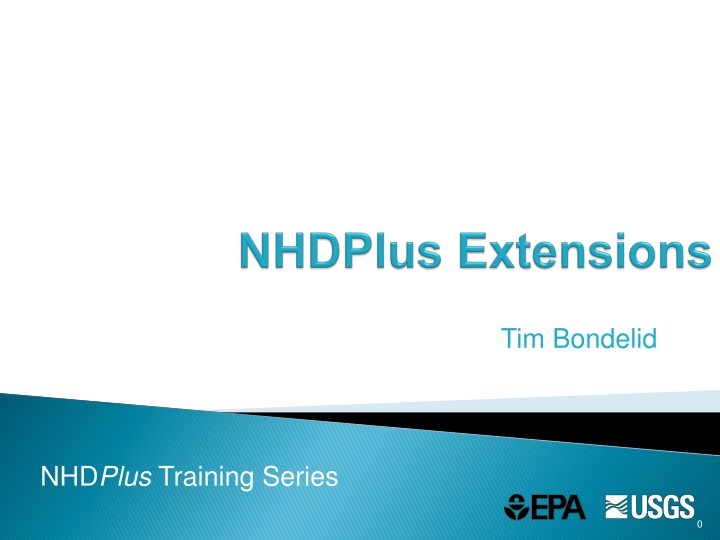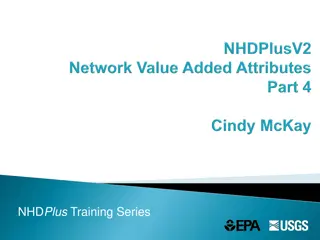
Flow Volume and Velocity Methods in Hydrology
This content explores the methods and data used in analyzing flow volume and velocity in hydrology, including the organization of data, calculation of velocity, and estimation processes such as the Enhanced Runoff Method and Vogel Method. It also delves into the Tennessee River Basin data organization and NHDPlusV21 datasets, offering insights into flow estimation and data quality assurance. The content emphasizes the importance of harmonized data and specific criteria for accurate flow calculations.
Download Presentation

Please find below an Image/Link to download the presentation.
The content on the website is provided AS IS for your information and personal use only. It may not be sold, licensed, or shared on other websites without obtaining consent from the author. If you encounter any issues during the download, it is possible that the publisher has removed the file from their server.
You are allowed to download the files provided on this website for personal or commercial use, subject to the condition that they are used lawfully. All files are the property of their respective owners.
The content on the website is provided AS IS for your information and personal use only. It may not be sold, licensed, or shared on other websites without obtaining consent from the author.
E N D
Presentation Transcript
Tim Bondelid NHDPlus Training Series 0
Help to Understand and Make Use of: Flow Volume and Velocity Methods and Data The Supporting Data Introduction 1
How the Data is Organized EROMExtension Flow and QA VogelExtension Flow Estimate Method VPUAttributeExtension How the data is developed and what is available using CA3T What is in the data tables; the most-used data fields How velocity is calculated Introduction 2
1. The Enhanced Runoff Method (EROM five-step process-based method EROM): A 2. The Vogel method Vogel Method: A Regression-based There is also the supporting data used by these methods called VPUAttributeExtensions VPUAttributeExtensions Introduction 3 3
Tennessee River Basin: \MS\06\ Data Organization 4 4
In \NHDPlusV21\MS\06: Data Organization 5 5
In \NHDPlusV21\MS\06: Data Organization 6 6
In \NHDPlusV21\MS\06: Data Organization 7 7
It is a five-step process for estimating flow A separate QA module is incorporated that produces flow QA statistics and data tables for users to do their own QA All of the input data is harmonized to the 1971-2000 time period, so the EROM flows consistently reflect this time period EROM uses USGS gage flow data for adjustments and QA The gage data must meet specific criteria Mean annual (MA) and mean monthly flows are developed 1. 2. 3. 4. 5. EROM 8
A. Runoff based on water balance model (RO) B. Excess ET component that takes into account excess evapo-transpiration in the stream channel area (EET) C. A regression of Step 2 flows on Gage flows using Reference gages (RGR) D. A capability for users to add, remove and transfer flows (PlusFlowAR) E. Adjustments to observed gage flows EROM 9
EROM (Slide courtesy of Dave Wolock, USGS) 10 10
EROM 11 11
Colorado River (Southwestern U.S.) Non-conservative routing model Conservative routing model Measured flow 30000 25000 Streamflow (cfs) 20000 15000 10000 5000 0 0 100000 200000 300000 400000 500000 600000 700000 Drainage basin area (km2) Method developed by Dave Wolock of USGS. (graphic courtesy of Dave Wolock) EROM 12 12
100,000 10,000 EROM Flow (cfs) 1,000 100 10 1 1 10 100 1,000 10,000 100,000 Gage Flow (cfs) Note: Blue is Step A flow, Purple is Step C flow EROM 13 13
Transfers flow from one flowline to another flowline EROM 14
Gage DA = 12 Gage Q = 13 Flowline Flow = 12 QAdj = 13 12 = 1 EROM 15 15
EROM Files are named EROM_nn0001.dbf where nn = time period MA = mean annual, 01 = January, etc. 0001 is used as the baseline, 0002 could be a scenario EROM 16 16
EROM Files are named EROM_nn0001.dbf where nn = time period MA = mean annual, 01 = January, etc. 0001 is used as the baseline, 0002 could be a scenario EROM 17 17
EROM QA Report is named EROMQA_0001.PDF It contains statistical measures of expected EROM flow accuracy EROM 18
EROMQA Files are named EROMQA_nn0001.dbf where nn = time period MA = mean annual, 01 = January, etc. These files are useful, for instance, for making graphs EROM 19 19
EROM 20 20
Uses a regression method for mean annual flow estimation Q = 10a * DAb * MAPc * MATd * BCF, a, b, c, d are regression coefficients BCF is the Bias Correction Factor Estimates for many networked flowlines Regression coefficients by Hydroregion Velocity estimates using Jobson method Vogel 21
The name of the Vogel Flow table is VogelFlow.dbf Note the large number of missing values (-9999) Vogel 22 22
Velocities are calculated using a method developed by Harvey Jobson of USGS. It is a multiple regression method using: Drainage Area Slope Flow There is also a method that does not require slope; used when there is a missing slope value. Velocity 23
NHDPlus V1 and initial V2.1 extensions Velocity - Jobson method used for streams, lakes and estuaries Time-of-travel none NHDPlus V2.1 improved extensions Velocity - Jobson method used for streams; back- calculated from modeled residence time for lakes; none for estuaries Time-of-travel length/velocity for streams; modeled residence time for lakes; none for estuaries Velocity 24
The Jobson method is valid ONLY for flowing waters It should not be used in lakes, reservoirs or estuaries Time-of-Travel (TOT) = length/velocity, can route upstream or downstream Velocity 25
EROM: Allocations of mean annual and mean monthly runoff, temperature and precipitation For Vogel: Accumulations of drainage area, mean annual temperature and precipitation Note: Divergence-routed methods are used to maintain a flow balance VPUAttributes 26 26
CA3T has been released as a user tool CA3T 27 27
For Example, Mean Annual Runoff: CA3T 28 28
CA3T 29 29
Average temperature (Deg.C*100) is computed by accumulating catchment allocations and then dividing by the cumulative drainage area (CumulativeArea.DivDASqKM) 30 30
CA3T 31 31
CA3T 32 32
CA3T 33 33
The effects of total versus divergence accumulations carry downstream This makes total routing complex CA3T 34 34
Total Accumulations get more interesting with multiple divergences CA3T 35 35
CA3T 36 36
VPUAttributes 37 37
Folder EROMExtension EROMExtension Folder Table(s) EROM_nn0001.DBF EROMQA_0001.PDF EROMQA_nn0001.DBF VogelFlow.DBF Cum Precip.txt Cum Precip.txt Table(s) EROM_nn0001.DBF EROMQA_0001.PDF EROMQA_nn0001.DBF VogelFlow.DBF VogelExtension VPUAttributeExtension VPUAttributeExtension VogelExtension Cum Temp.txt Incrlat.txt IncrPrecip .txt IncrTemp .txt RO .txt RO .txt Cum Temp.txt Incrlat.txt IncrPrecip .txt IncrTemp .txt VPUAttributes 38 38
Folder EROMExtension EROMExtension Folder Table(s) EROM_nn0001.DBF EROMQA_0001.PDF EROMQA_nn0001.DBF VogelFlow.DBF Cum Precip.txt Cum Precip.txt Table(s) EROM_nn0001.DBF EROMQA_0001.PDF EROMQA_nn0001.DBF VogelFlow.DBF VogelExtension VPUAttributeExtension VPUAttributeExtension VogelExtension Cum Temp.txt Incrlat.txt IncrPrecip .txt IncrTemp .txt RO .txt RO .txt Cum .RO.txt Cum Temp.txt Incrlat.txt IncrPrecip .txt IncrTemp .txt NEW! -- VPUAttributes 39 39
VPUAttributes 40 40
Additional information on NHDPlus is available from the NHDPlus website documentation page. You are encouraged to read and reference the NHDPlusV21 User Guide and other NHDPlus documentation. The NHDPlus team maintains a user email list and periodically sends emails regarding new tools, data, documentation, and events. If you would like to be on the user list, send an email to nhdplus-support@epa.gov The NHDPlus team also provides technical support to users of the data and tools. If you have a technical support question, please send a detailed email to nhdplus-support@epa.gov Resources 41 41

